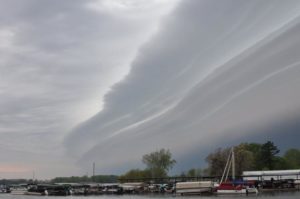Thunderstorms rolled through Madison between 8:30 and 9 a.m. Thursday May 16th. Stunning “flying-saucer” clouds accompanied the dark skies of the leading edge of the storm.
These dark, protruding clouds are “shelf clouds.” The clouds look like a shelf and in this case appeared as a stack of shelves. They are one of several distinct visible features of a vigorous thunderstorm complex.
Air that is cooler than its environment tends to sink as long as it can stay cooler than its surroundings. Sometimes prior to a thunderstorm rain you may feel a blast of cool air. This is the downdraft spreading out as it hits the surface.
The dense, cold air of the downdraft forms the gust front at the surface and flows out ahead of the storm. The gust front can lift the warm, moist air near the ground, forcing it upward to form updrafts in developing thunderstorms.
Clouds are sometimes observed above the gust front. The shelf cloud is one such cloud. It forms as the gust front forces air near the surface to rise.
A shelf cloud looks very ominous but does not produce damaging weather by itself, although it can precede severe weather by a few minutes. This was the situation on Thursday, and the storms produced brief downpours and wind gusts to around 30 mph.


